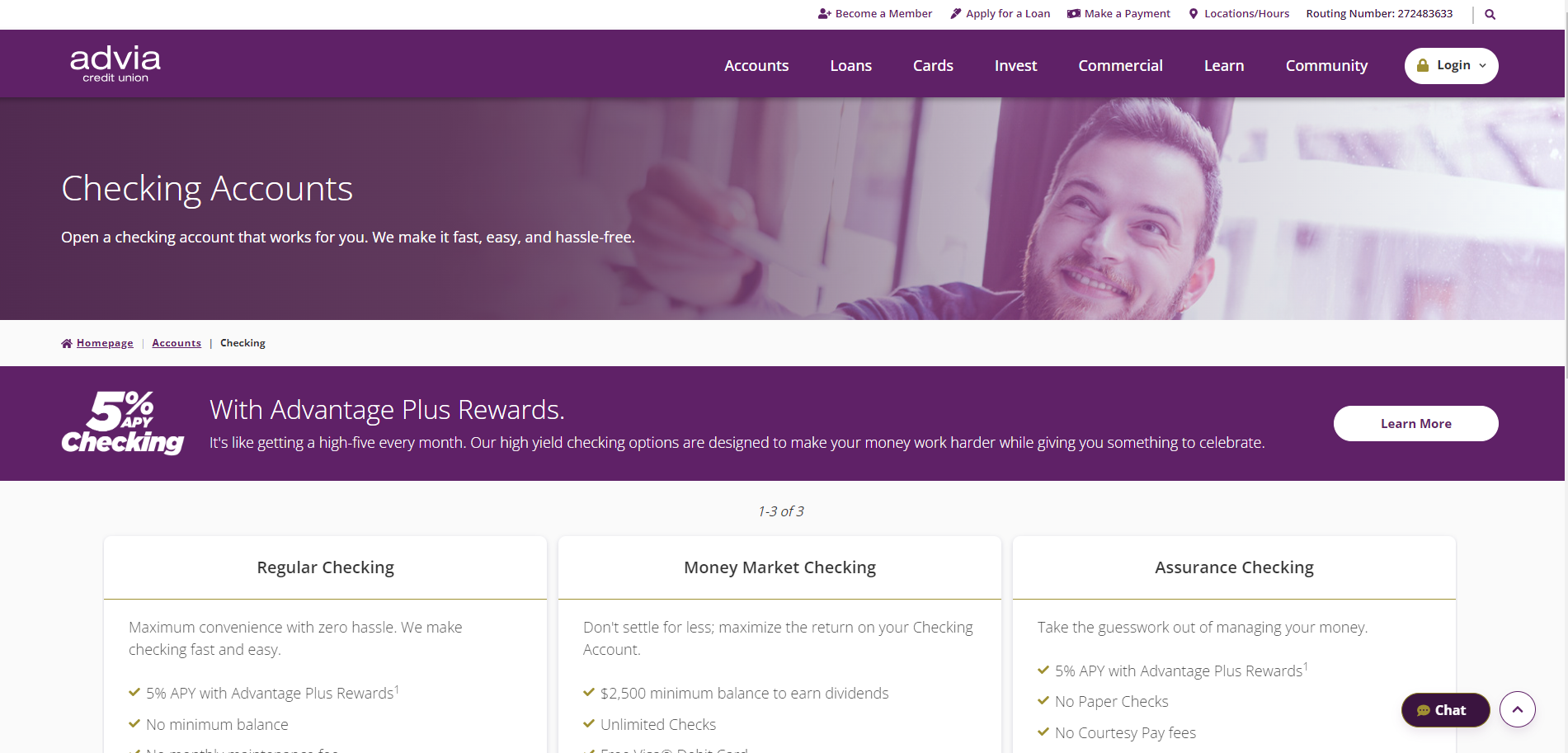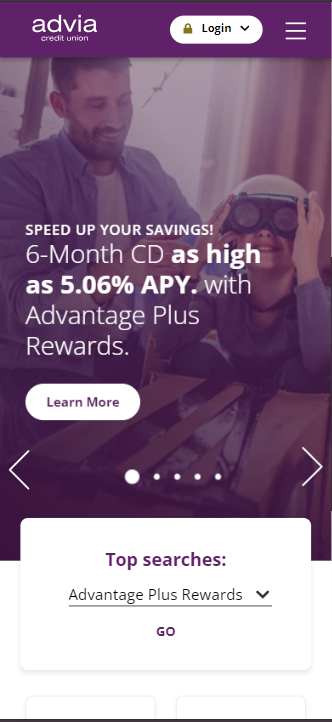ADVIA CREDIT UNION
Services we provide:
- Discovery
- Digital Strategy
- Content Analysis
- Custom Integrations
- UX/UI Design
- Website Development
- Hosting
- Support
About Advia Credit Union
Advia Credit Union has a mission to provide financial advantages to its members by providing advice, advocating for members, and offering advantages other financial institutions don’t. This is accomplished through innovative financial solutions and a new, scalable website. For this new site, Advia sought to proactively provide the quickest and easiest digital solution for members to get the best user experience. Advia is not like other financial institutions; this is illustrated in Advia’s commitment to serving the ever-changing financial needs of its members. One of its core values is to drive progress by engaging in a spirit of innovation and developing new digital service tools for its members. This led to an innovative website redesign to give members easy access to information digitally.
The Challenge
The old website was not intuitive, and the overall digital experience lacked. The lending areas of the old site for both mortgages and auto loans were not producing results. With increased in mobile traffic, the site needed an improved mobile user experience. A major challenge facing Advia’s business team was the organization and content hierarchy of the old site. The content was repetitive and text-heavy, and members were confused about where to find the information they sought. Other obstacles included Advia’s team being unable to easily update the content and structure of the pages on the old website.
Goals for the New Site:
- Improved navigation layout
- Measurable enhancements
- Increase time spent on the website
- Meets brand standards with redesign
- Increase overall visitors engagement
- Increase content management efficiency
Advia wanted to create a “one-stop” resource center to educate members on digital banking—including forms, links, documents, and video tutorials. Two goals for the new Advia Credit Union website were simplifying content and allowing self-service for members. Advia did not want to reinvent the wheel in terms of UI but wanted to deliver a better digital experience to its members and potential new members. The new website provides a clean and clear navigation experience to eliminate clutter and confusion.
The Right Platform
SilverTech reviewed several CMS/DX platforms with Advia. Progress Sitefinity was the chosen platform, giving Advia a fully optimized digital experience. Using the page templates on the Sitefinity platform allows Advia to accomplish the goals for the new site by enhancing the design and layout of the website with ease. The new website improves the user experience with the use of properly placed navigation buttons and call to actions (CTAs) clearly directing users through the content on the page to the sub-pages. Advia’s site has an engaging navigation and advanced filter functionality allowing users to get to the content they are looking for with ease. Additionally, the Advia content team can seamlessly update and create pages within the Sitefinity CMS, keeping the website current and relevant.
RESULTS
Exceptions to Web Content and Mobile App Accessibility Requirements for State and Local Governments
By: Paul Creme | 2/26/25
On April 24, 2024, the Federal Register published the Department of Justice’s final rules for Title II of the Americans with Disabilities Act as amended (the “ADA”). The rules are considered the technical standard for web content and mobile apps; Web Content Accessibility Guidelines (WCAG) Version 2.1, Level AA.
The rules ensure state and local government services, programs, and activities are available and accessible on websites and mobile apps for people with disabilities. As implementation clarity is non-negotiable, there are some exceptions that do not require web and mobile app content to comply with WCAG 2.1, Level AA.
THE EXCEPTIONS:
Archived Web Content
Information that may be rarely used or is outdated, not needed, or repeated somewhere else. The web content must meet all four of the following points to be considered an exception to the requirements:
- 1. The content was created prior to the effective date or reproduces paper documents or the contents of other physical media.
- 2. The content is kept only for reference, research, or recordkeeping.
- 3. The content is kept in a special area for archived content.
- 4. The content has not been changed since it was archived.
Preexisting Conventional Electronic Documents
Documents that meet both of the following points are not required to meet WCAG 2.1, Level AA:
- 1. The documents are word processing, presentation, PDF, or spreadsheet files.
- 2. They were available on the state or local government’s website or mobile app before the required date the state or local government must comply with this rule.
The exception does not apply if the documents are currently being used to apply for, access, or participate in a state or local government’s services and/or programs. Even if they were posted before the date the government must comply with the rule.
Contractual, Licensing, or Other Arrangements with a Public Entity
Content posted by a third party where said third party is not posting due to contractual, licensing, or other arrangements with a public entity. This may include such things as meeting notices by non-governmental entities.
Individualized Password-Protected Documents
Documents that meet all three of the following points do not need to meet WCAG 2.1, Level AA:
- 1. The documents are word processing, presentation, PDF, or spreadsheet files.
- 2. The documents are about a specific person, property, or account.
- 3. The documents are password-protected or otherwise secured.
This could include payment portals.
Preexisting Social Media Posts
If the state or local governmental entity is unable to meet the new requirements there are some alternatives such as having two versions of the same web and mobile app content. In other words, one version that is not accessible and another version that is accessible and provides all the same information and features. The second version is called a “conforming alternate version.” However, the entity may not have a main web page that is inaccessible and a separate accessible version of the same content, because people with disabilities should get equal access to that content on the same page.
Technicalities & Timing
In some limited situations, state and local governments may be able to show that their web content or mobile apps have minor attributes that do not meet WCAG Version 2.1, Level AA. In these cases, the issue would have to be so small that it would not interfere with the accessibility of the content or mobile app.
State and local governments cannot use this part of the rule to avoid compliance, and if web content does not fully meet WCAG 2.1, Level AA, there are many things the government would have to prove to show they are not in violation of the rule.
State and local governments must make sure their web content and mobile apps meet WCAG 2.1, Level AA within 2 - 3 years of when the rule was published (April 24, 2024), depending on their population. In other words, state and local entities have about 2 years to enforce fully compliant sites and mobile apps unless an exemption applies.
You can find more information about why the Department of Justice is enforcing these compliance requirements and their timelines here under “Requirements by Entity Size.” Please reach out if you have any questions regarding your website's compliance.



